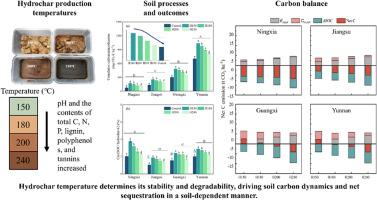平衡碳氢化合物应用中的能量输入和碳输出:对土壤碳固存的温度依赖效应
IF 5.8
2区 生物学
Q1 AGRICULTURAL ENGINEERING
引用次数: 0
摘要
碳氢化合物是一种从生物质热液碳化中提取的富含碳的物质,已成为一种有前途的土壤改良剂,可以增强碳固存和促进可持续农业实践。然而,其稳定性、可降解性和生产过程中的能源投入之间的权衡仍未得到充分探讨,特别是在不同土壤类型中。本研究系统评价了不同温度(150、180、200和240℃,记为H150-H240)下产生的碳氢化合物对宁夏(N)、江苏(J)、广西(G)和云南(Y) 4个代表性水稻土土壤碳矿化(Cm)和净固碳的影响。结果表明,低温水炭(H150-H180)具有较高的活性碳比例,增加了微生物生物量,提高了水解酶活性,显著刺激了Cm(高达127%)。相比之下,高温烃类(H240)表现出更强的生物稳定性,Cm降低,腐殖化系数更高(88 - 97%),表明其具有长期碳储存的潜力。能源评估表明,虽然实验室规模的碳氢化合物生产导致净二氧化碳正排放(57-114吨二氧化碳/公顷),但扩大规模可大大减少能源足迹。值得注意的是,在低碳土壤(N, J)中应用碳氢化合物导致净碳固存(高达- 6.80 t CO2 ha - 1),而在高碳土壤(G, Y)中,只有高温碳氢化合物有助于净碳固存。这些发现强调了平衡碳氢化合物生产条件和土壤特征以优化其减缓气候变化潜力的必要性。本研究通过整合碳稳定性、能源效率和特定场地适宜性,促进土壤改良剂的清洁生产,为可持续土地管理和气候智慧型农业做出贡献。本文章由计算机程序翻译,如有差异,请以英文原文为准。

Balancing energy inputs and carbon outcomes in hydrochar applications: Temperature-Dependent effects on soil carbon sequestration
Hydrochar, a carbon-rich material derived from hydrothermal carbonization of biomass, has emerged as a promising soil amendment for enhancing carbon sequestration and promoting sustainable agricultural practices. However, the trade-offs between its stability, degradability, and energy inputs during production remain underexplored, particularly across diverse soil types. This study systematically evaluated the effects of hydrochars produced at varying temperatures (150, 180, 200, and 240 °C; denoted as H150–H240) on soil carbon mineralization (Cm) and net carbon sequestration in four representative paddy soils from Ningxia (N), Jiangsu (J), Guangxi (G), and Yunnan (Y). Results revealed that low-temperature hydrochars (H150–H180) significantly stimulated Cm (up to 127 %) due to their higher proportion of labile carbon, enhanced microbial biomass, and increased hydrolytic enzyme activities. In contrast, high-temperature hydrochar (H240) showed greater biological stability, with reduced Cm and higher humification coefficients (88–97 %), indicating potential for long-term carbon storage. Energy assessments demonstrated that while lab-scale hydrochar production led to net positive CO2 emissions (57–114 t CO2 ha−1), scaling up substantially reduced the energy footprint. Notably, application of hydrochar to low-SOC soils (N, J) resulted in net carbon sequestration (up to −6.80 t CO2 ha−1), whereas in high-SOC soils (G, Y), only high temperature hydrochar contributed to net carbon sequestration. These findings underscore the need to balance hydrochar production conditions and soil characteristics to optimize its climate mitigation potential. This study advances the cleaner production of soil amendments by integrating carbon stability, energy efficiency, and site-specific suitability, contributing to sustainable land management and climate-smart agriculture.
求助全文
通过发布文献求助,成功后即可免费获取论文全文。
去求助
来源期刊

Biomass & Bioenergy
工程技术-能源与燃料
CiteScore
11.50
自引率
3.30%
发文量
258
审稿时长
60 days
期刊介绍:
Biomass & Bioenergy is an international journal publishing original research papers and short communications, review articles and case studies on biological resources, chemical and biological processes, and biomass products for new renewable sources of energy and materials.
The scope of the journal extends to the environmental, management and economic aspects of biomass and bioenergy.
Key areas covered by the journal:
• Biomass: sources, energy crop production processes, genetic improvements, composition. Please note that research on these biomass subjects must be linked directly to bioenergy generation.
• Biological Residues: residues/rests from agricultural production, forestry and plantations (palm, sugar etc), processing industries, and municipal sources (MSW). Papers on the use of biomass residues through innovative processes/technological novelty and/or consideration of feedstock/system sustainability (or unsustainability) are welcomed. However waste treatment processes and pollution control or mitigation which are only tangentially related to bioenergy are not in the scope of the journal, as they are more suited to publications in the environmental arena. Papers that describe conventional waste streams (ie well described in existing literature) that do not empirically address ''new'' added value from the process are not suitable for submission to the journal.
• Bioenergy Processes: fermentations, thermochemical conversions, liquid and gaseous fuels, and petrochemical substitutes
• Bioenergy Utilization: direct combustion, gasification, electricity production, chemical processes, and by-product remediation
• Biomass and the Environment: carbon cycle, the net energy efficiency of bioenergy systems, assessment of sustainability, and biodiversity issues.
 求助内容:
求助内容: 应助结果提醒方式:
应助结果提醒方式:


